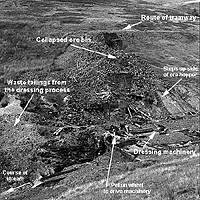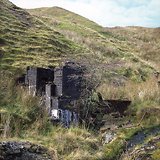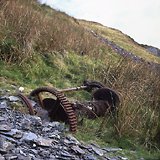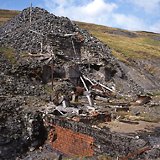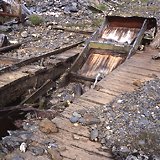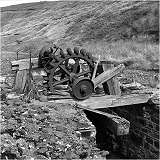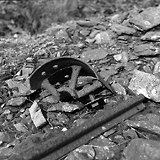|
Nantiago typifies many of the small mines in that during it's working life many years were spent closed and out of production as it struggled to survive. Originally known as Plynlimmon Mine, work appears to have begun in 1846, the lesse being Robert Parry. The initial burst of activity didn't seem to come to much, however, by 1853 the mine was working again with money being invested to provide an 'iron tramway', hydraulic equipment and installation of zinc air pipes; despite this investment the mine once again closed. In 1860 the mine was back in production, with a waterwheel having been purchased from Esgairlle providing power to the site. By 1863 the workings had reached a 30 fathom level yet in March 1865 the entire mine, complete with all machinery and equipment, was advertised for sale. In 1872 the company gained a new director and 1873 saw the installation of a new 60ft water wheel, production at the mine increased and was constant until 1888 when activity at the mine ceased yet again. A new company was formed to work the mine in 1900 and John Mills & Co. of Llanidloes Foundry were employed to install a new 56ft water wheel for pumping, along with a large dressing plant powered by two pelton wheels, a stone crusher, rolls and jigs. During the years of prosperity at the mine a Crossley gas engine was installed to assist the water wheel during times of drought and winter conditions. The mine finally closed at the end of the First World War, it's total production having been 1709 tones of lead ore and 1929 tons of zinc ore.
Down the valley slightly the wheel pit from one of the large water wheels can be found, along with the impressions on the hillside where tracks and paths led down the valley. Various other features from the mine are passed before reaching the dressing area refitted in 1900. Ore was brought from the mine along a tramway to the top of a large ore bin where it could be stored prior to processing on the floor down below. The route of the tramway is visible as a straight line running along the hillside. The Ore Bin itself has largely collapsed, although it's rubble is still present, climbing up the right hand side of the structure are a series of steps cut into the solid rock. Lying nearby are the remains of a number of trucks. The dressing area is located at the base of the valley below the ore bin. The foundations and remains of the buildings that once stood here can still be seen along with the concrete floors that were once under cover. Water plays a large part in the process of dressing the metal ore prior to it's sale, at Nantiago this was provided by the stream that runs down the centre of the site. Emerging from the rubble of the ore bin are a number of pipes that brought water to the Pelton Wheels that drove the machinery, one of which is slowly collapsing into the stream below. Lying on the ground in the area can be found numerous small artefacts that probably would have been stolen by unscrupulous visitors had the mine been any easier to access.
|

